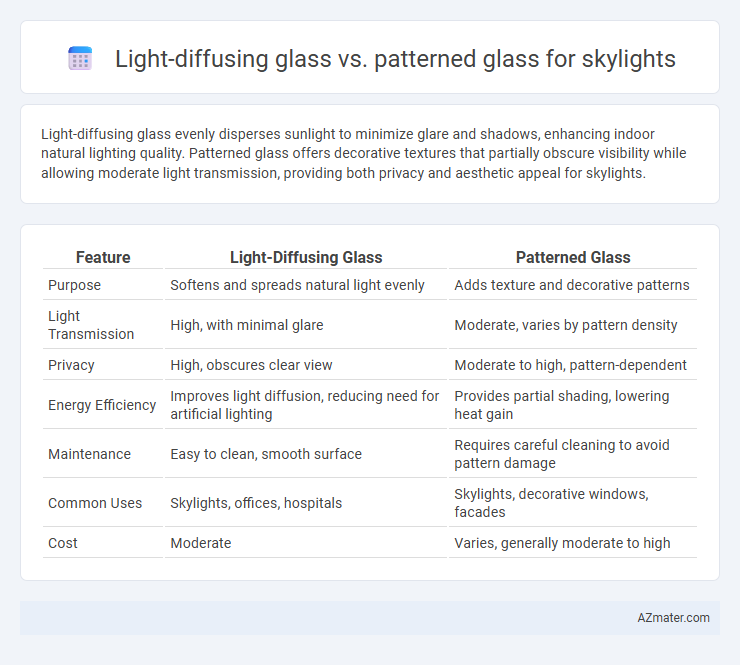Light-diffusing glass evenly disperses sunlight to minimize glare and shadows, enhancing indoor natural lighting quality. Patterned glass offers decorative textures that partially obscure visibility while allowing moderate light transmission, providing both privacy and aesthetic appeal for skylights.
Table of Comparison
| Feature | Light-Diffusing Glass | Patterned Glass |
|---|---|---|
| Purpose | Softens and spreads natural light evenly | Adds texture and decorative patterns |
| Light Transmission | High, with minimal glare | Moderate, varies by pattern density |
| Privacy | High, obscures clear view | Moderate to high, pattern-dependent |
| Energy Efficiency | Improves light diffusion, reducing need for artificial lighting | Provides partial shading, lowering heat gain |
| Maintenance | Easy to clean, smooth surface | Requires careful cleaning to avoid pattern damage |
| Common Uses | Skylights, offices, hospitals | Skylights, decorative windows, facades |
| Cost | Moderate | Varies, generally moderate to high |
Introduction to Skylight Glass Options
Light-diffusing glass for skylights evenly disperses natural sunlight, reducing glare and creating a soft, ambient indoor lighting effect. Patterned glass incorporates textured designs that not only provide privacy but also add decorative elements while controlling light transmission. Both options enhance energy efficiency and comfort by optimizing daylight distribution in architectural spaces.
What is Light-Diffusing Glass?
Light-diffusing glass is specially designed to scatter sunlight evenly across a space, reducing glare and harsh shadows in skylights. It enhances natural light distribution while maintaining privacy by obscuring direct views through the glass. Unlike patterned glass, which features embossed or etched designs for decorative effects, light-diffusing glass optimizes illumination quality in architectural applications.
What is Patterned Glass?
Patterned glass for skylights features textured surfaces that scatter light to reduce glare and enhance privacy while maintaining natural illumination. Unlike light-diffusing glass, which evenly disperses light through a milky or frosted finish, patterned glass uses embossed designs such as ribbed, hammered, or prismatic patterns to create visual interest and control light direction. This type of glass is ideal for architectural applications where both functional light management and aesthetic appeal are important.
Light Transmission and Brightness
Light-diffusing glass offers uniform light transmission by scattering incoming sunlight evenly, reducing glare and enhancing ambient brightness without compromising natural illumination. Patterned glass transmits light through embossed or textured surfaces, creating decorative effects but often resulting in slightly lower brightness due to light scattering and absorption within the patterns. For skylights, light-diffusing glass maximizes brightness and consistent illumination, while patterned glass prioritizes aesthetic appeal with moderate light transmission.
Privacy and Visual Comfort
Light-diffusing glass enhances privacy by scattering incoming sunlight, reducing glare and preventing clear views through the skylight, which improves visual comfort in residential and commercial spaces. Patterned glass also provides privacy by obscuring direct sightlines with etched or embossed designs, but it may allow more directional light and shadows, potentially affecting uniform light distribution. Choosing between light-diffusing and patterned glass depends on the desired balance between privacy levels and the quality of natural light diffusion for optimal indoor comfort.
Energy Efficiency and Thermal Control
Light-diffusing glass for skylights enhances energy efficiency by evenly dispersing natural light, reducing the need for artificial lighting and minimizing heat hotspots. Patterned glass offers superior thermal control by incorporating textured surfaces that disrupt solar heat gain while maintaining adequate daylight transmission. Both glass types contribute to energy savings; light-diffusing glass optimizes illumination distribution, whereas patterned glass effectively limits heat ingress for improved indoor climate regulation.
Aesthetic Impact on Interior Spaces
Light-diffusing glass enhances interior spaces by evenly dispersing natural light, creating a soft, glow-like ambiance that reduces harsh shadows and glare, ideal for maintaining privacy without compromising brightness. Patterned glass offers a decorative element with varied textures, adding visual interest and dynamic light patterns that can transform skylight illumination into artistic focal points. Both options influence aesthetic appeal, with light-diffusing glass prioritizing subtle uniformity and patterned glass delivering textured complexity in skylight design.
Durability and Maintenance
Light-diffusing glass for skylights offers enhanced durability with its tempered or laminated composition, resisting impacts and weathering over time, while requiring minimal maintenance due to its smooth surface that prevents dirt accumulation. Patterned glass, although visually appealing with etched or embossed designs, may be slightly more prone to dust and grime buildup within the textures, necessitating more frequent cleaning to maintain clarity. Both types generally provide strong resistance to UV damage, but light-diffusing glass tends to hold up better in harsh environmental conditions, ensuring longer-lasting performance and reduced upkeep.
Cost Comparison
Light-diffusing glass for skylights typically costs more upfront due to its advanced manufacturing process that ensures uniform light distribution and reduced glare. Patterned glass is generally more affordable, offering decorative aesthetics while still providing some light diffusion but with less consistency in light spread. Long-term energy savings may favor light-diffusing glass, as it can reduce the need for artificial lighting and cooling, potentially offsetting its higher initial price.
Choosing the Right Glass for Your Skylight
Light-diffusing glass evenly disperses natural sunlight, reducing glare and creating a soft, ambient illumination ideal for spaces requiring balanced light. Patterned glass offers a decorative element while providing moderate light transmission and privacy through its textured surface, making it suitable for aesthetic and functional needs. Selecting the right glass for your skylight depends on your desired light quality, privacy requirements, and architectural style preferences.

Infographic: Light-diffusing glass vs Patterned glass for Skylight
 azmater.com
azmater.com